Evolution (copy)
5.0(1)
5.0(1)
New
Card Sorting
1/52
Study Analytics
Name | Mastery | Learn | Test | Matching | Spaced |
|---|
No study sessions yet.
53 Terms
1
New cards
evolution
change in allele frequencies over time in a species or a population
these changes come from mutations typically and affect how these species adapt to the non static environment
these changes come from mutations typically and affect how these species adapt to the non static environment
2
New cards
Lamarck
these changes come from mutations typically and affect how these species adapt to the non static environment
3
New cards
What was Lamarck right about?
was right abt use and disuse
giraffe necks grew due to it being __used__
and the human appendix shrunk due to __disuse__
giraffe necks grew due to it being __used__
and the human appendix shrunk due to __disuse__
4
New cards
What was Lamarck wrong about?
falsely held the idea that acquired characteristics are inherited (while this is sometimes true it is mostly wrong)
5
New cards
Who is Darwin?
\-traveled around the world and theorized natural selection.
\-Published Origin of Species book
\-Published Origin of Species book
6
New cards
three takeaways from darwins’s book
\
1. Resources are limited.
2. Organisms compete for survival.
3. There is variation among individuals in a population.
1. Resources are limited.
2. Organisms compete for survival.
3. There is variation among individuals in a population.
7
New cards
How was Darwin’s thinking impacted by his voyage?
he gathered evidence and made observations that led to his theory of evolution
saw many different species and evonirments and how those organisms lived
this led to him writing a book
saw many different species and evonirments and how those organisms lived
this led to him writing a book
8
New cards
What was Darwin’s theory?
his theory is that evolution occurs because of natural selection
9
New cards
Darwin’s book and why it took him so long to publish it
His first book was *On the Origin of Species* and it was published in 1859
it took him so long due to the fear of the reaction to this theory of evolution and how it went against the church
he also put it off to gather more evidence for his theory
it took him so long due to the fear of the reaction to this theory of evolution and how it went against the church
he also put it off to gather more evidence for his theory
10
New cards
8 characteristics of his book
1. Populations have enormous __reproductive__ potential.
2. Population sizes tend to remain relatively __stable__.
3. Resources are __limited__.
4. Organisms __compete__ for survival.
5. There is __variation__ among individuals in a population.
6. Much variation is __heritable__.
7. __Fit__ individuals are able to produce more offspring that survive longer.
8. __Evolution__ occurs as advantageous traits accumulate over time.
11
New cards
5 main pieces of evidence for evolution
homologous/analogous structures, biogeography paleontology, molecular biology, and embryology
12
New cards
homologous structures
structures found in different organisms that all evolved from a common ancestor
over time the structures developed
ex. upper limb bones of human, bat, dog, and whale
\
starts from one ancestor; ends up in various
over time the structures developed
ex. upper limb bones of human, bat, dog, and whale
\
starts from one ancestor; ends up in various
13
New cards
analogous structures
structures in various species that are similar but they evolved from very different ancestors
ex. penguin and porpoise
opposite of homologous
ex. penguin and porpoise
opposite of homologous
14
New cards
vestigial
remnants of once useful traits that have shruken due to disuse
ex. appendix
ex. appendix
15
New cards
paleontology
the study of fossils that are usually found in sedimentary rocks
16
New cards
isotope dating
is a technique that is used to date materials such as rocks or carbon, in which trace radioactive impurities were selectively incorporated when they were formed
compares the abundance of a naturally occurring radioactive isotope within the material to the abundance of its decay products, which form at a known constant rate of decay
2 main types → carbon isotopes vs uranium isotopes
compares the abundance of a naturally occurring radioactive isotope within the material to the abundance of its decay products, which form at a known constant rate of decay
2 main types → carbon isotopes vs uranium isotopes
17
New cards
Carbon isotope dating
measuring age of fossil by how much carbon is left;
In C-14;
if starting with 10 grams; it would take 1 half-life (5730) years to decrease by half.
IF MORE THAN 23K YEARS OLD: Uranium isoptope
In C-14;
if starting with 10 grams; it would take 1 half-life (5730) years to decrease by half.
IF MORE THAN 23K YEARS OLD: Uranium isoptope
18
New cards
half life
the time taken for the __radioactivity__ of a specified __isotope__ to fall to half its original value.
19
New cards
uranium isotopes
(like U-238) has a half-life of 4.5 billion years
20
New cards
fossil types
\
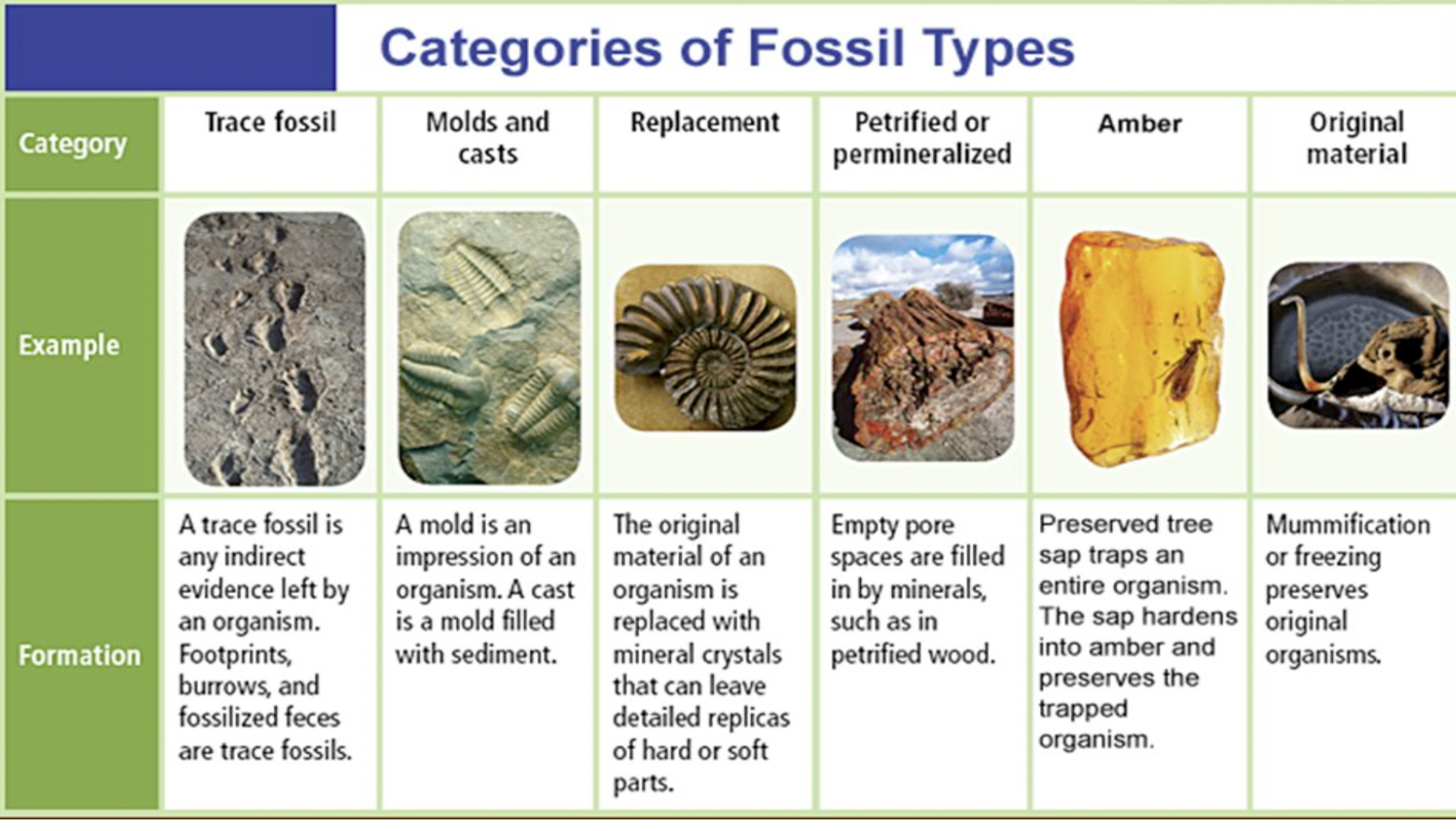
21
New cards
molecular biology
\
comparisons of DNA/RNA/amino acids sequences in various species indicates how closely (or distantly) related they are to each other
ex. comparing __hemoglobin__ amino acid sequences in various vertebrates
ex. comparing __cytochrome-c__ (a protein found in mitochondria and chloroplasts) in species
ex. comparing gene sequences
comparisons of DNA/RNA/amino acids sequences in various species indicates how closely (or distantly) related they are to each other
ex. comparing __hemoglobin__ amino acid sequences in various vertebrates
ex. comparing __cytochrome-c__ (a protein found in mitochondria and chloroplasts) in species
ex. comparing gene sequences
22
New cards
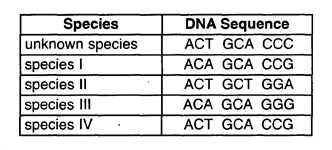
DNA percentage similarities for these:
23
New cards
embryology
the study of embryos and their development
vertebrates share a surprising number of similarities when they are embryos
stages of development happen in the same sequence in vertebrates (timing and size in each stage varies)
many vestigial structures in some species
vertebrates share a surprising number of similarities when they are embryos
stages of development happen in the same sequence in vertebrates (timing and size in each stage varies)
many vestigial structures in some species
24
New cards
vestigial
leftovers from ancestors (highly reduced in size/functionality)
25
New cards
Common structures in vertebrate embryos:
limb buds
gill folds
tail
yolk sac (doesnt actually contain yolk in us because of the umbilical cord)
gill folds
tail
yolk sac (doesnt actually contain yolk in us because of the umbilical cord)
26
New cards
adaption
the process of adapting to something (such as environmental conditions)
27
New cards
divergent evolution
various species arising from one common ancestor over time
ex.
A = ancestral bird, B = hummingbird, C = ostrich
A = ancestral fish, B = dogfish, C = hammerhead shark
A = ancestral desert plant, B = saguaro cactus, C = organ pipe cactus
ex.
A = ancestral bird, B = hummingbird, C = ostrich
A = ancestral fish, B = dogfish, C = hammerhead shark
A = ancestral desert plant, B = saguaro cactus, C = organ pipe cactus
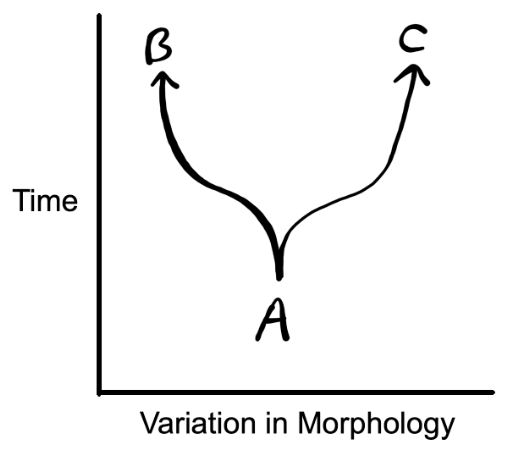
28
New cards
convergent evolution
two species becoming more like in morphology over time
ex.
A = ancestral amphibian, B = ancestral reptile, C = salamander, D = gecko
A = ancestral marsupial, B = ancestral placental mammal, C = sugar glider, D = flying squirrel
ex.
A = ancestral amphibian, B = ancestral reptile, C = salamander, D = gecko
A = ancestral marsupial, B = ancestral placental mammal, C = sugar glider, D = flying squirrel
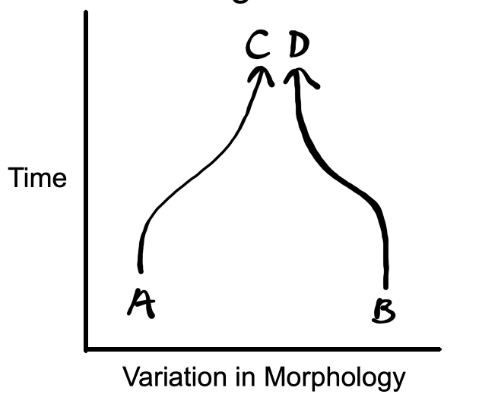
29
New cards
coevolution
a symbiotic relationship that causes two species’ evolutions to affect each other over time
Examples → Bees/flowering plants, predator/prey relationships, parasite/host
Examples → Bees/flowering plants, predator/prey relationships, parasite/host
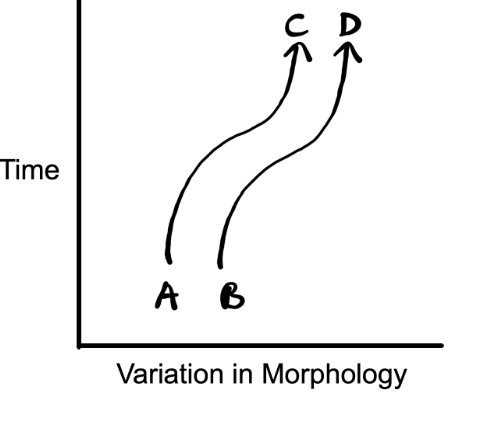
30
New cards
sexual selection
the phenomenon in which varying traits are present in males vs. females in many animals species (corresponding to something that indicates “increased fitness’) - it comes down to what’s more/less attractive in potential mates
Examples → lion’s manes in males, peacock feathers, horns or antlers in many mammals, birds (dances, feather displays, songs)
Examples → lion’s manes in males, peacock feathers, horns or antlers in many mammals, birds (dances, feather displays, songs)
31
New cards
adaptation
a heritable trait that helps an organism take advantage of its surroundings
\
better adapted individuals = individuals with more/better traits
\
better adapted individuals = individuals with more/better traits
32
New cards
natural selection
process by which organisms that are more fit, or adapted, to its environment survive to produce offspring
organisms “selected” to live on
\
Over production +variation => natural selection + inheritance
organisms “selected” to live on
\
Over production +variation => natural selection + inheritance
33
New cards
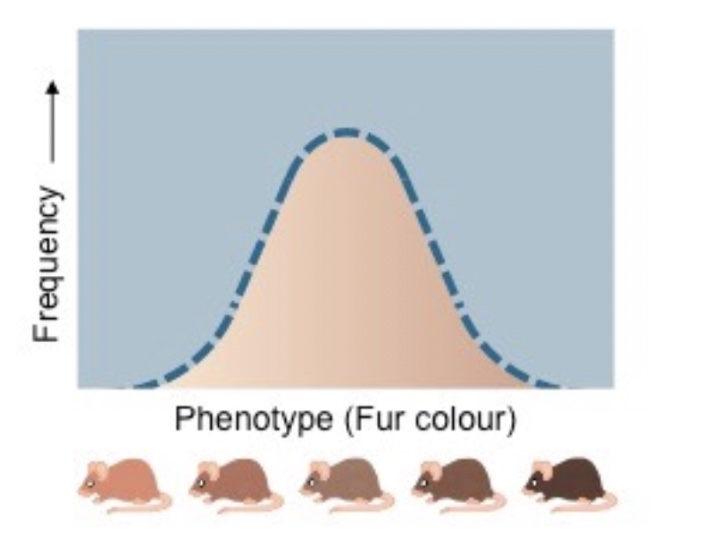
Normal distribution
ex. human height
no pressure at all
(unlike stabilizing no pressure that causes a certain height to considered perfect.)
ex. human height
no pressure at all
(unlike stabilizing no pressure that causes a certain height to considered perfect.)
34
New cards
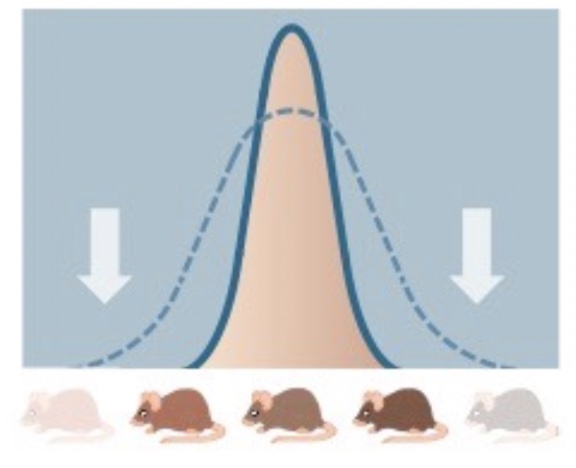
Stabilizing distribution
both extremes have less survival vs middle; just right
ex. plant height; too short = not enough sun; too tall= susceptible to breaking easily
both extremes have less survival vs middle; just right
ex. plant height; too short = not enough sun; too tall= susceptible to breaking easily
35
New cards
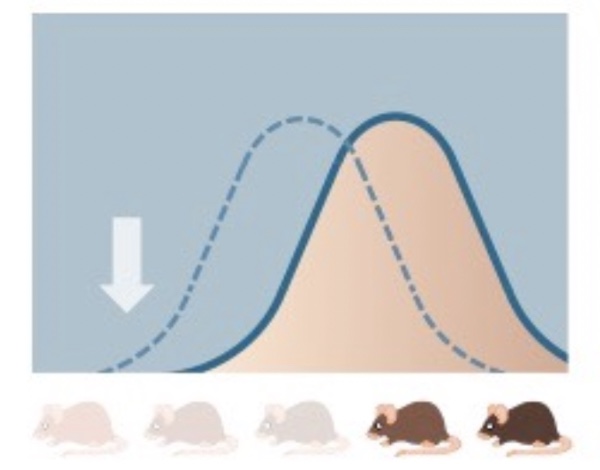
Directional distribution
(can shift to either end of spectrum)
less survival in one extreme vs the other
ex. Beak sizes
(can shift to either end of spectrum)
less survival in one extreme vs the other
ex. Beak sizes
36
New cards
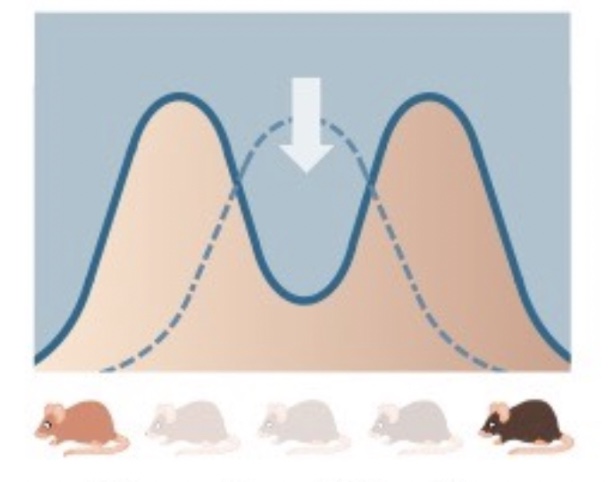
Disruptive distribution
ex. lightest and darkest furred organisms are preferred in an ares with dark and white sand
ex. lightest and darkest furred organisms are preferred in an ares with dark and white sand
37
New cards
artificial selection
humans manipulating breeding of plants, animals, etc. for our own wants/needs
Ex. = domesticated dogs, cats, livestock, silkworms
Ex. = agriculture (every fruit/veggie you’ve ever eaten)
Ex. = domesticated dogs, cats, livestock, silkworms
Ex. = agriculture (every fruit/veggie you’ve ever eaten)
38
New cards
heterozygote advantage
the case where heterozygous individuals have “the best of both worlds” in a sense - providing the opportunity for offspring to inherit different traits (and keep in mind, the phenotypes that are most fit can change over time due to environmental change or circumstances changing!)
\
ex. sickle cell anemia (recessive=affected with lack of nutrients; hetero= immune to malaria and have normal blood for functionality: dominant= not immune at al; normal
ex. can have a chance of passing on a beneficial trait that is recessive.
\
ex. sickle cell anemia (recessive=affected with lack of nutrients; hetero= immune to malaria and have normal blood for functionality: dominant= not immune at al; normal
ex. can have a chance of passing on a beneficial trait that is recessive.
39
New cards
adaptive radiation
numerous species **radiating** from a single ancestor over a long period of time and spreading out across a lot of different regions
Ex. → Darwin’s Galapagos finches
Ex. → The Silversword Alliance (plants) of Hawai’i
Ex. → Darwin’s Galapagos finches
Ex. → The Silversword Alliance (plants) of Hawai’i
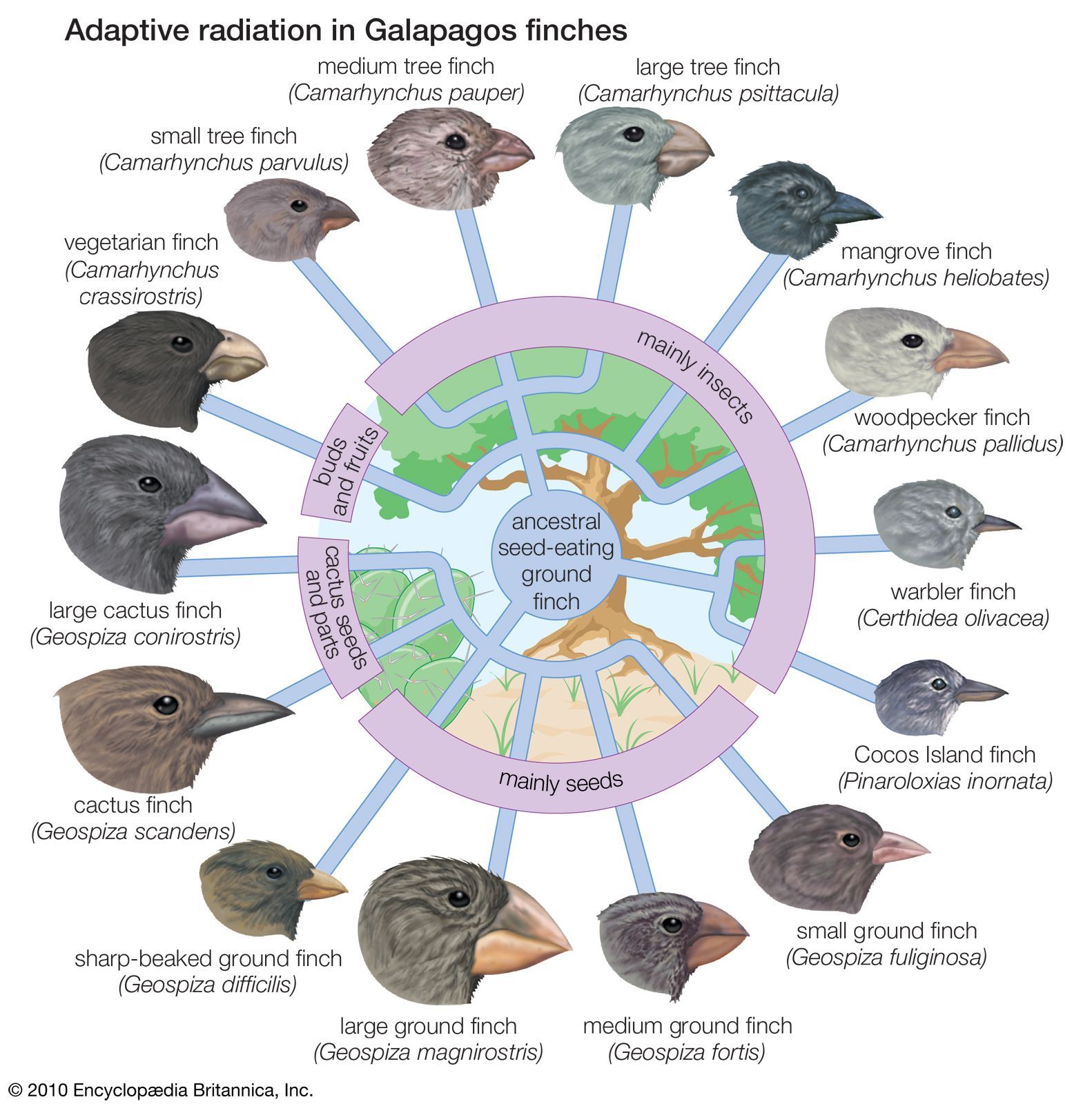
40
New cards
gene flow
immigration and emigrations of individuals in/out of a population
41
New cards
genetic drift
when the allele frequencies of a population change, not due to natural selection, but due to genetic probabilities
\
ex. blue birds become more common for no reason; population with 1/2 black and white rabbits, but most black rabbits die in an accident not due to their trait which causes the probability of white rabbits to increase.
\
ex. blue birds become more common for no reason; population with 1/2 black and white rabbits, but most black rabbits die in an accident not due to their trait which causes the probability of white rabbits to increase.
42
New cards
bottleneck
huge reduction in number of individuals of a population/species; resulting reduced population will begin to evolve quickly to survive and regenerate.
\
\
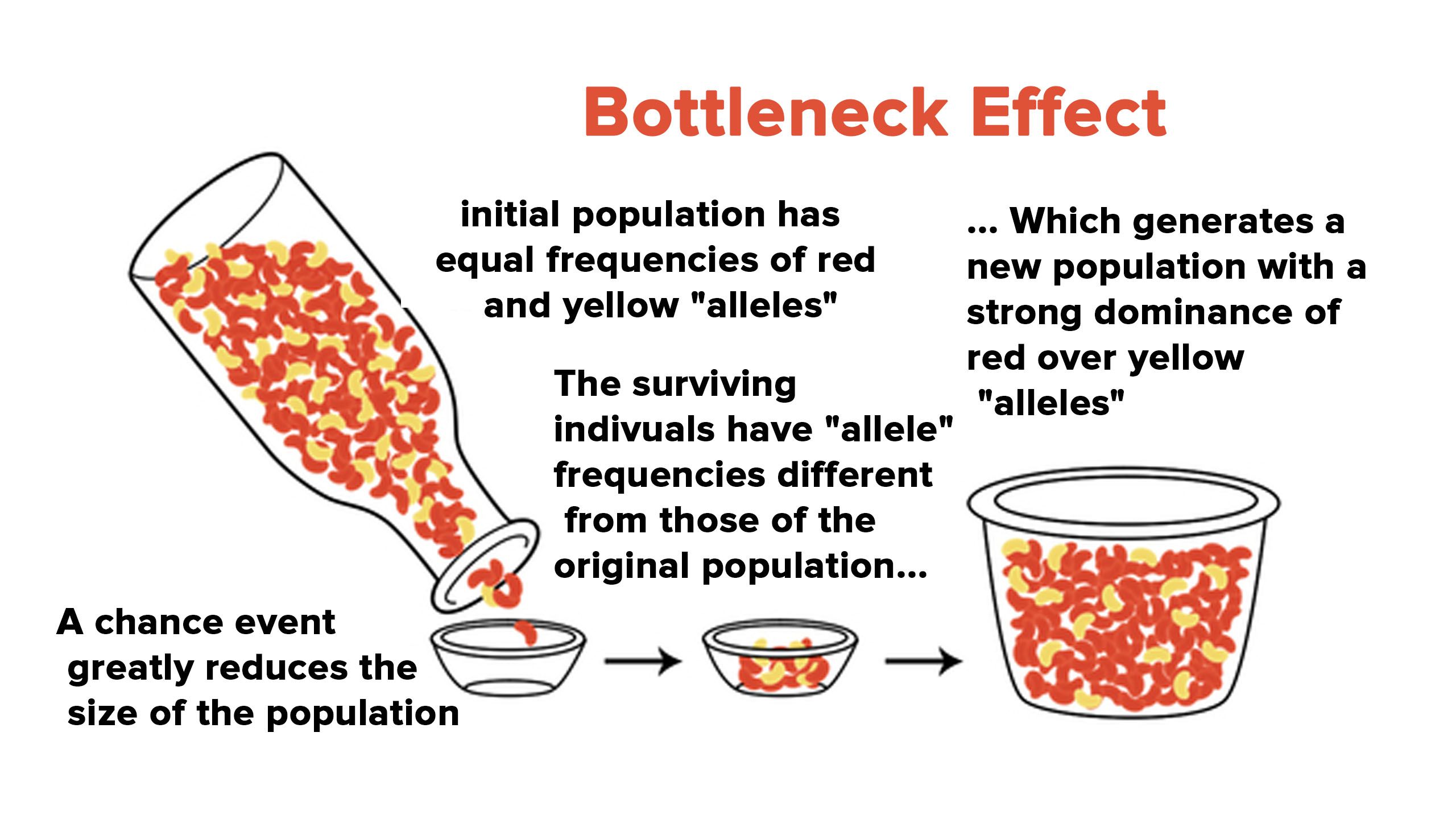
43
New cards
founder effect
individuals arrive at a new territory or recently formed landmass → their genes set the stage; initiate it all
44
New cards
Hardy-Weinberg theorem/equilibrium
**The formulas:**
**p + q = 1**
**p^2 + 2pq + q^2 = 1**
\
p = frequency of the dominant allele (ex. = 0.3 would be 30%)
q = frequency of the recessive allele (ex. = 0.7 would be 70%)
\\n
p^2 = frequency of homozygous dominant individuals
2pq = frequency of the heterozygous individuals
q^2 = frequency of the homozygous recessive individuals
**p + q = 1**
**p^2 + 2pq + q^2 = 1**
\
p = frequency of the dominant allele (ex. = 0.3 would be 30%)
q = frequency of the recessive allele (ex. = 0.7 would be 70%)
\\n
p^2 = frequency of homozygous dominant individuals
2pq = frequency of the heterozygous individuals
q^2 = frequency of the homozygous recessive individuals
45
New cards
5 requirements for Hardy-Weinberg theorem
1. No natural selection
2. No mutations
3. No sexual selection (random mating)
4. No immigration/emigration (no gene flow)
5. No small populations
46
New cards
reproductive isolation
the inability of a species to breed successfully with related species due to geographical, behavioral, physiological, or genetic barriers or differences; can cause speciation
\
ex. two populations of birds begin to separate as each begin to have a diff preference of dance patterns.
\
ex. two populations of birds begin to separate as each begin to have a diff preference of dance patterns.
47
New cards
how reproductive isolation leads to new species
if a part of a species is isolated from the other than the isolated part can reproduce and evolve without any input from the other part resulting in new **allele frequencies** (evolution) over time which eventually result in a new species
48
New cards
speciation
the formation of new species due to reproductive isolation
49
New cards
Prezygotic isolation (type of reproductive isolation)
Habitat isolation
Temporal isolation
Behavioral isolation
Mechanical isolation
Gametic isolation
Temporal isolation
Behavioral isolation
Mechanical isolation
Gametic isolation
50
New cards
Postzygotic isolation (type of reproductive isolation)
Reduced hybrid viability
Reduced hybrid fertility
Hybrid breakdown
Reduced hybrid fertility
Hybrid breakdown
51
New cards
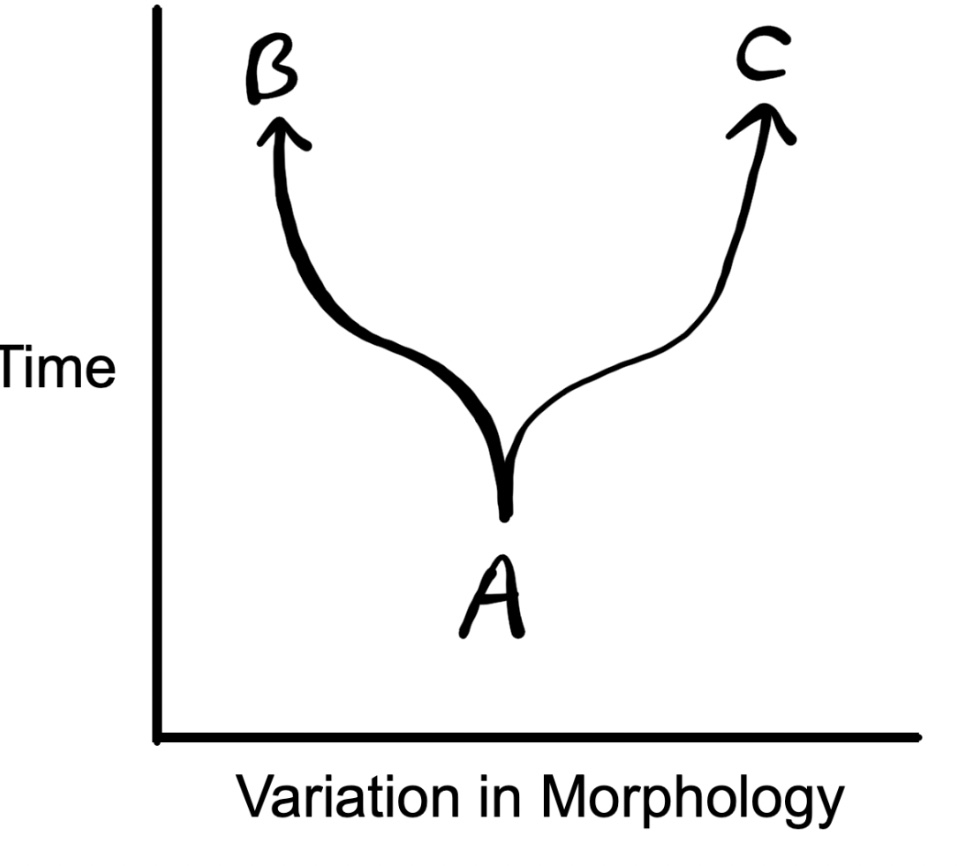
\
Divergent Evolution
52
New cards
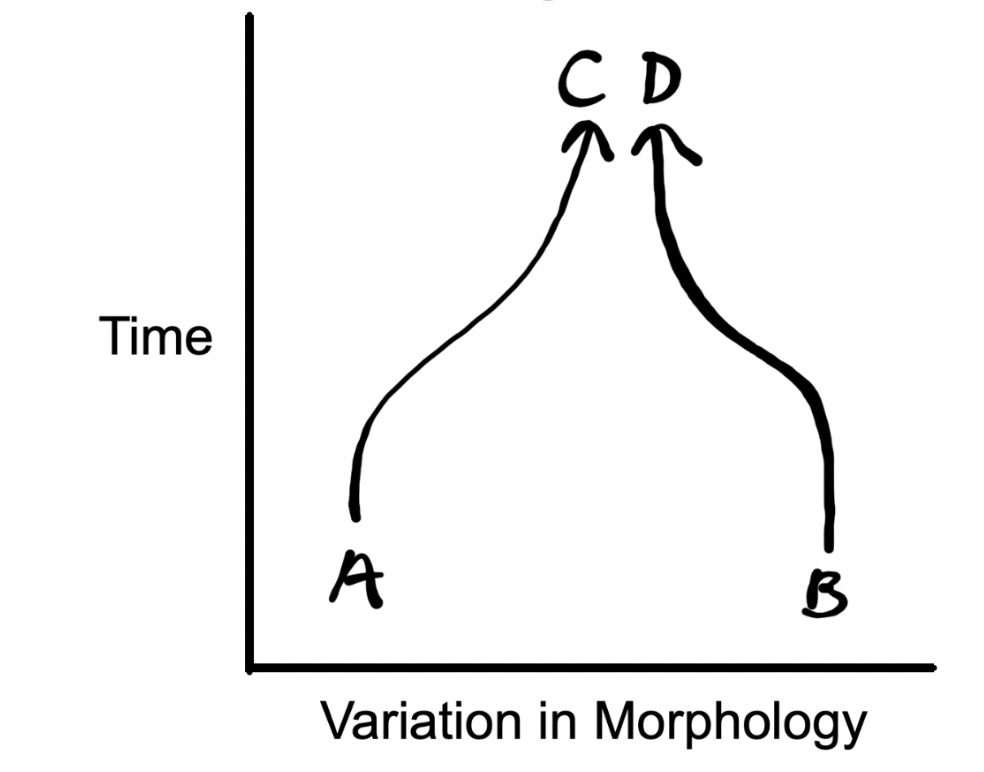
Convergent evolution
53
New cards
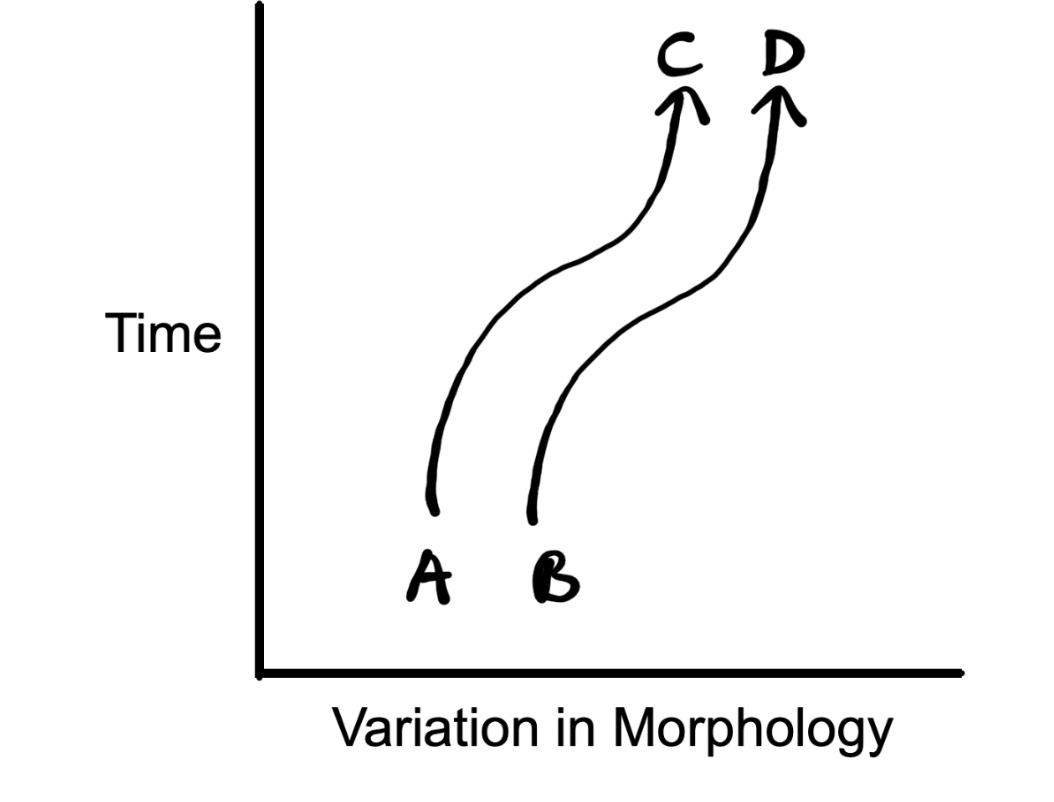
Coevolution